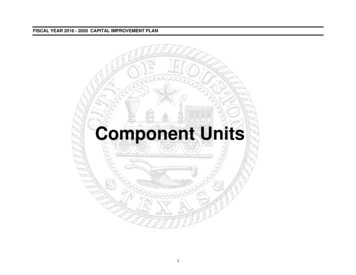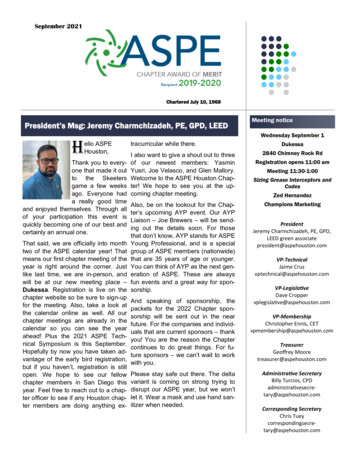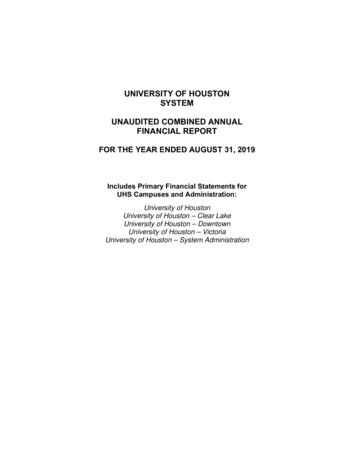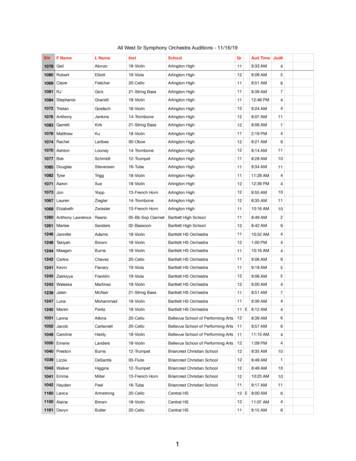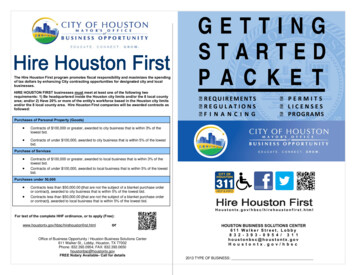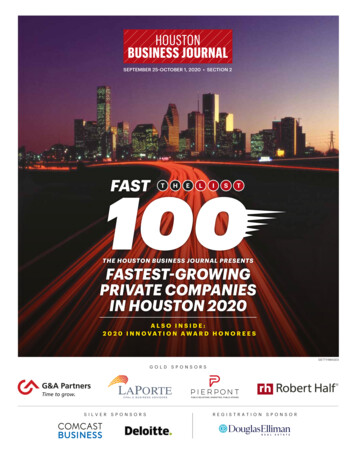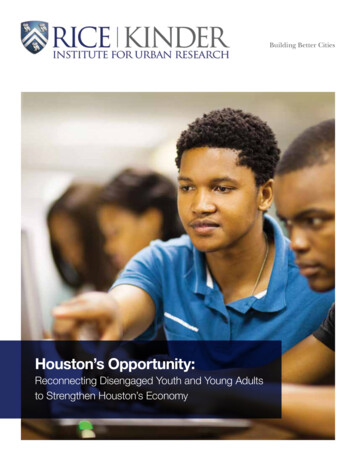
Transcription
Building Better CitiesHouston’s Opportunity:Reconnecting Disengaged Youth and Young Adultsto Strengthen Houston’s Economy
Generously underwritten by
Executive SummaryThough the U.S. economy is gradually showing signs ofrebounding, a group of young people known as OpportunityYouth and Young Adults (OYYA) continues to lag behind. Defined asyoung people ages 16 to 24 who neither work nor attend school, theOYYA population is growing both nationally and in the Houston area.This study aims to identify characteristics of the group and highlightthe most successful practices to address its needs.BackgroundAn estimated 6.7 million individuals nationally and 111,000 individuals locally are categorized as OYYA.Given the obstacles they face at the individual, family and societal levels, as well as the often-cyclicalnature of poverty, supporting Opportunity Youth and Young Adults in finding pathways to success canbe a complex challenge. However, this is also a population that has numerous strengths that shouldbe celebrated and even leveraged as assets. There is a critical need for communities to take steps toprovide pathways to opportunity for this population.The cost to the taxpayer for inaction is potentially vast—an estimated 30 billion in the Houston areaalone. A relatively modest investment in comparison in programs that lead to credentials with value inthe labor market for this population would help open doors for OYYA and go a long way toward reducing the burden.MethodologyUsing Census data as well as the data from the Kinder Houston Area Survey, a team of researchers soughtto quantify, locate and highlight characteristics of the Houston-area OYYA population. Researcherswere also able to use data from the Health of Houston Survey to identify health characteristics of thepopulation and calls from the 2-1-1 system to identify service requests and needs for this population.The research team also conducted extensive interviews with service providers, as well as young peoplethat are currently or were formerly members of the OYYA population, to better understand challengesfacing the population as well as approaches to support them.Finally, this report was informed by the national nonprofit Jobs for the Future to highlight case studiesof successful service models.Houston’s Opportunity: Reconnecting Disengaged Youth and Young Adults to Strengthen Houston’s Economy1
FindingsCharacteristics T he population of Houston-areaOpportunity Youth and YoungAdults represents 14.2 percent ofyoung people ages 16 to 24 in thearea. Nearly one in seven youngadults in the Houston area is neitherworking nor in school. D espite assumptions about “inner-city youth,” some of the largestnumbers of OYYA in the Houstonregion are outside the city inareas near Angleton, Baytown,Cloverleaf, Humble and Texas City.In Houston, they are found in areasincluding Alief, Five Corners andFifth Ward. Approximately 78 percent of this population has a high school credential or higher but is not inschool or working; 22 percent do not have a high school credential. This suggests a critical need foron-ramps to postsecondary/training programs leading to credentials with value in the labor market. Despite difficulties securing employment, many OYYA are positive about their economic outlook.More than 1 in 4 members of the local OYYA population rate job opportunities as “poor,” yet 72percent say they expect to be better off within three or four years, indicating the aspirations of thispopulation to succeed.Contributing Factors Interviews reveal that OYYA feel a sense of disconnection from the education system. Other challenges include limited guidance and family responsibilities that may hinder their ability to pursuework or school. Service providers and young people stated in interviews that criminal backgrounds can be a majorobstacle to securing employment. There is also a disconnect between employers and the OYYApopulation, who may not be aware of training opportunities and pathways to middle-skills jobs.Recommendations For service providers, the first interaction they have with an OYYA is critical. Actively reaching outto young adults and building relationship with them is the key to serve this population effectively.An “Opportunity Assessment Tool” can be used to facilitate the dialogue and help identify notonly the barriers facing an individual but can also help determine his or her assets and aspirations. “Wrap-around services” that target multiple areas of need simultaneously may help the OYYA population navigate a fragmented social services system and keep them engaged. Forming cross-sector community-based partnerships may help ensure efficiency in resource allocation and servicedelivery, and increase social impact. Alternative credentialing and education programs, outside the typical high school environment,have been proven to re-engage students who are otherwise struggling. Innovative training programs such as the “Earn and Learn” model with enhanced mentoring andpersonalized curricula may fill a critical service gap.2Houston’s Opportunity: Reconnecting Disengaged Youth and Young Adults to Strengthen Houston’s Economy
Table of Contents4Introduction7Characteristics of Houston Area OYYA45789910Purpose of this reportHouston’s OYYA: Nearly one in seven young adultsLocation in and around HoustonDemographics, family circumstances and household incomeEducation characteristics and outlookHealth and other socioeconomic correlatesSources of concern among Houston’s young people: Insight from 211 Call Data11Contributing Factors16Recommendations31Conclusion32Appendix: Opportunity Assessment 30Interviews & Focus GroupsDisconnection, Poverty, and FamilyEducational BarriersWorkforce BarriersOther BarriersService GapsRecommended PracticesOpportunity Assessment ToolEngaging YouthWrap-around ServicesDevelop Community PartnershipsApplying What We LearnedEducation PathwaysCareer PathwaysPolicy ImplicationsHouston’s Opportunity: Reconnecting Disengaged Youth and Young Adults to Strengthen Houston’s Economy3
IntroductionAs the country gradually recovers from the worst recession ingenerations, there are signs of renewed vibrancy in the U.S.economy. State unemployment claims are dropping, the nationalhousing market is improving, corporate profits are stabilizing, andthe unemployment rate is falling. Despite this progress, there’sone particular category of Americans who have been left behindand are poised to suffer economically—as well as in myriad otherways—if governments, non-profits, businesses and civic leadersfail to respond appropriately to their circumstances. They are the“Opportunity Youth and Young Adults,” or OYYA.Also known as “disconnected youth,” the category includes young people, ages 16 to 24, who are neither working nor attending school. In Houston, as well as in many U.S. cities, the disadvantages facingthe growing OYYA population are a central social and economic concern. Data indicate that once anindividual does become disconnected from school or the workforce, the effects of diminished earningsand educational deficits become increasingly difficult to address. Failure to address the needs of thisgroup in particular may create negative conditions that can be passed onto the community and thenext generation. In addition to the damages of inequality to community cohesion, when we miss outon the opportunity to integrate these young people, the economic impact is substantial with taxpayercosts reaching upwards of 13,900 per year and additional “social costs” reaching 37,450.1 Over a lifetime, a single 16-year-old opportunity youth may cost taxpayers a lump sum of 258,240, and the totalsocial burden is estimated at 755,900.Cost-effective, targeted investments in education, workforce development and social support systemsare all necessary to reduce the social and economic costs associated with this inequality. But the costsof these programs are minimal compared to the consequences of inaction. It’s critical that leadersproactively find ways to create opportunities to reengage those young people. And by drawing on theuntapped potential of Opportunity Youth and Young Adults, we make Houston stronger.Purpose of this reportThis report aims to advance the work already being undertaken by government agencies and non-profit organizations that are seeking ways to expand opportunities for disconnected youth nationwide.Specifically, the report seeks to quantify the size of the OYYA population in Houston, to highlight characteristics of this population and to identify areas where the population is most concentrated, using acombination of data from the U.S. Census and from local surveys.4Houston’s Opportunity: Reconnecting Disengaged Youth and Young Adults to Strengthen Houston’s Economy
FIGURE 1OYYAPopulationin 012201480,62016.4%60,00040,00020,00001990Source: IPUMS, Census 1990,2002, ACS 2008–2012, ACS2010–2014.2000The report also explores some of the most intractableobstacles facing the OYYA population and outlines somepromising strategies to help them find a job or return toschool. As part of this effort, researchers interviewed 22 individuals representing stakeholder organizations in education,non-profits, workforce and government agencies that servethe OYYA population, as well as 25 young adults ages 18–24who are or have been “disconnected.”Finally, researchers consulted closely with the nationalnon-profit Jobs for the Future to highlight the most promising service models and strategies that can meet the needs ofthis population in the region. This report aims to establish asolid knowledge base on the OYYA issue, to increase awareness of the obstacles facing this population and to shine aspotlight on what works in Houston and beyond. With theseefforts, we provide the foundation for more productive conversation—and action—around this critical issue.FIGURE 2Houston OYYAPopulationrelative to othermetropolitanareasHouston’s OYYA:Nearly one in seven young adultsOpportunity Youth and Young Adults are defined asindividuals between the ages of 16 and 24 who areneither attending school nor working.The OYYA population in the Houston metropolitan area isgrowing. Between 1990 and 2000, it increased from 80,620,or 16.4 percent of the youth population to 118,528, or19.3 percent of the youth population. Since then, it hasdipped slightly—falling to 110,324 in 2012 and rising backto 111,021 in 2014. 2 Nearly one in seven young adults inHouston region falls under the definition. Though the number of OYYA has increased from 1990 to 2014, its percentagehas decreased, suggesting some success locally at addressingthe challenge.Percent of 16 to 24 year olds not working or in school, ranked:Houston-Baytown-Sugar Land, TX Metro Area, All, 201223.9%14.7%4.9%Bakersfield, CA Metro AreaMadison, WI Metro AreaSource: IPUMS, Policy Link/PERE National Equity Atlas,www.nationalequityatlas.orgHouston’s Opportunity: Reconnecting Disengaged Youth and Young Adults to Strengthen Houston’s Economy5
Nationally, 6.7 million individuals, or 17 percent of the 16- to24-year-old population, are estimated to meet these criteria.3Over the last several decades,the percentage of individualsconsidered to be OYYA has increased from about 4 percentof young adults in 1988 to anestimate of 17 percent in 2012.Not surprisingly, this numberfluctuates with economic cycles; in better economic times,the percentage declines, whilein recessionary periods, thepercentage increases.Compared to other U.S. metropolitan areas, Houston ranksin the middle in terms of therelative size of its OYYA population.4 The relative size of the OYYA population amongthe 10 most populous U.S. metropolitan areas ranges from9 percent to 16 percent.By 2020, nearly two-thirds of all American jobs will requireat least some education and training beyond high school.5In the Houston region, there are more than 1.4 millionmiddle-skill jobs that require technical training at thepost-secondary level and offer economic mobility and middle-income wages.6 Yet many young people do not have anypost-secondary credentials or skills that meet those needs.A cohort study of the 69,847 public school students whostarted 8th grade in 2004 in the Houston region, as definedFIGURE 3Leaks in theEducationalPipeline: 8thgrade cohortprogressionover 11 yearsin Houston100%90%by the Texas Education Agency, shows 54 percent of studentsenrolled in a post-secondary education institution for a twoor four-year degree. Only 14,945, or 21 percent, completed apost-secondary certificate or degree program in Texas.7The economic potential of an OYYA cohort is very large.Over the full lifetime of a cohort of 110,000 OYYA in theHouston region, the aggregate taxpayer burden amountsto 28.4 billion in 2011 dollars, or 30.2 billion in presentvalue terms. The aggregate social burden is estimated at 88.3 billion in 2016 dollars. The success of this populationis critical for the health of Houston’s economic future andthe well-being of all Houstonians.100%94%80%Fall 2004 Cohort70%68%60%50%54%40%30%20%21%10%0%Source: Data for the FY 20048th grader cohort. Data fromTexas Education Agencyand Texas Higher EducationCoordinating Board68th Grade(N 69,847)High SchoolEnrollee(N 65,511)High SchoolDiploma(N 47,539)Higher EducationEnrollee(N 37,806)Higher EducationCredential(N 14,945)Houston’s Opportunity: Reconnecting Disengaged Youth and Young Adults to Strengthen Houston’s Economy
Characteristics ofHouston Area OYYABefore policymakers and service providers can consider effectiveways of serving the Opportunity Youth and Young Adultpopulation, they need a full understanding of the characteristics ofthis population and the challenges they face.Location in and around HoustonProviding effective services first requires knowing where the largest numbers of disconnected young people reside. We find that OYYA live throughout the Houston metro area, but the population is particularlysizable in several specific areas. Despite pervasive assumptions regarding “inner-city youth,” some of thelargest numbers of OYYA are found outside of the center of the city, beyond the Loop 610 boundary.In particular, OYYA are most likely to be found in the areas near Angleton, Baytown, Cloverleaf,Humble and Texas City. They also reside in large numbers in the outskirts of the city, particularlyin parts of southwest Houston such as Alief and Five Corners (see Figure 4). However, there is oneFIGURE 4MontgomeryCountyNumber ofyouth aged16 to 19 whoare not inschool and areunemployedin Houstonmetropolitanarea, byZIP code(2010–2014)MontgomeryHarrisCountyThe afFort BendCountySugarLandBaytownOak IslandNassauBayPearlandSanta FeNeedvilleTexas BacliffGalvestonDamonNumber of Youth Aged 16 to 19 who areNot in School and are Unemployed,ACS 2010–2014Old River-WinfreeBellaireManvel01 - 4040 - 9090 - 358Liberty : ACS 2010–2014.Houston’s Opportunity: Reconnecting Disengaged Youth and Young Adults to Strengthen Houston’s Economy7
FIGURE 5The WoodlandsPinehurstNumber ofOYYA aged16 to 19 whoare not inschool and areunemployed inHarris County,by ZIP Code(2010–2014)Dayton th WardSpring rk PlaceWeston LakesFive CornersNumber of Youth Aged 16 to 19 who areNot in School and are Unemployed,ACS 2010–2014SugarLandPearlandBacliff01 - 4040 - 9090 - 358ManvelTexas CitySanta FeSource: ACS 2010–2014.notable Inner Loop community with a sizable OYYA population: the Fifth Ward, located just northeast of downtownHouston. Programs aiming to serve this population may thusbe of greatest benefit in the highlighted areas of the map,and they should consider offering their services in multiplelocations both inside and outside of the central city.8Demographics, family circumstances andhousehold incomeThe map above refers only to the youngest OYYA, those ages16 to 19. According to ACS 2010–2014 five-year estimates,FIGURE 6Racialcompositionof OpportunityYouth andYoung Adults inHouston MetroArea (2010–2014)100%90%NassauBay4%48%approximately 73 percent of the OYYA are between the agesof 20 and 24. However, the patterns are fairly consistentwhen considering 20- to 24-year-olds.9 More than half (54percent) of the population is female. OYYA in Houston aremost likely to be Hispanic, representing almost half of theOYYA population (48 percent). African-Americans are alsoover-represented in this population.Data from the Kinder Houston Area Survey (KHAS)—anannual survey of adults residing in the Houston area, alsohelp shed light on the Opportunity Youth population.10 For8%43%80%OtherHispanic70%Non-Hispanic black60%50%40%23%30%20%19%Non-Hispanic white30%24%10%0%Opportunity Youth andYoung AdultsYouth and Young Adultsaged 16–24Source: ACS 2010–2014.8Houston’s Opportunity: Reconnecting Disengaged Youth and Young Adults to Strengthen Houston’s Economy
the purposes of this study, researchers focused on survey respondents who live in Harris County and participated in thesurveys conducted over the 12 years from 2005 to 2016.According to KHAS data, a much larger proportion ofHouston’s OYYA population is married or in a domesticpartnership, compared to their non-OYYA peers in HarrisCounty. Thirty-eight percent of OYYA are currently married—more than three times the rate of non-OYYA young adults inHouston. Similarly, nearly half of the OYYA population livesin a household with a child present, while 84 percent of nonOYYA young adults live in households without children.Being disconnected is both a consequence and cause ofpoverty. Compared to their peers, OYYA are more likely tolive in households with an annual income below 25,000(55 percent compared to 32 percent). While unsurprising,this result emphasizes the need to consider the economicreality of this population when designing and implementingprograms aimed to serve them.It is worth noting that among OYYA who are married or havea domestic partner, 91 percent have a partner who is working full- or part-time. It is unclear from the available datawhat proportion of this segment of the OYYA population isactually in need of work, especially when young children areat home, but their partners provide a valuable connection tothis group of people.Education characteristics and outlookBy definition, OYYA are more likely than their non-OYYA peersto have lower levels of educational attainment, as well as lower rates of college attendance and completion. However, it’sworth underlining the extent of this disparity. More than halfof the non-OYYA population has post-secondary education,but this is the case for only one-third of the OYYA population.Programs aimed at reaching out to this population can buildon its positive outlooks and motivation. The survey dataindicate that OYYA are only slightly less optimistic abouttheir future than their non-OYYA counterparts. Despite theircircumstances, fully 72 percent of OYYA said they expectedto be better off within three to four years, and just 5 percentthought their situation would get worse.Not surprisingly, however, OYYA are more likely to say thatjob opportunities in Houston are “poor.” This statistic reflects the OYYA’s perception of the dearth of jobs availableto them, and it also underscores the need to develop programs—and just as importantly, connect OYYA to programs—that can help them gain access to employment opportunities.Health and other socioeconomic correlatesIn addition to the Kinder Houston Area Survey, anothersource of data—the Health of Houston Survey—can providefurther information about the behavioral and health characteristics of this population.11TABLE 1. OYYA Characteristics18–24Non-OYYAOYYANever Married (%)85.657.8Married/partnership12.138.184.449.9 25k31.854.725k – 50k33.330.950k – 75k17.79.475k – 100k7.41.4100k 9.93.6Less than HS10.022.2HS Degree37.646.6Some College (no A.A.)16.112.02 or 3 years / A.A.23.512.0B.A. College elationship StatusChildrenHousehold with No Child (%)Household Income* (%)Education (%)Job Opportunities (%)ExcellentSource: Kinder Houston Area Surveys (2005–2016), Harris County.* Note that about one third of the respondents of each group chose not to reveal their household income.Opportunity Youth and Young Adults in Harris County havesignificantly more difficulties than their non-OYYA peersin paying for day-to-day expenses. For example, OYYA weremore than twice as likely as their non-OYYA peers to reportdifficulty buying food. Only 16 percent of non-OYYA report“sometimes,” “often,” or “always” having difficulty buyingfood, compared to 35 percent of OYYA. Additionally, 25percent of the OYYA population “sometimes,” “often,” or“always” had difficulty paying their rent or mortgage, compared to 15 percent of the non-OYYA population.These economic difficulties are reflected in negative healthcircumstances. In particular, there are staggering differencesbetween the two populations’ self-reported health status. Whilealmost two-thirds of young people in the non-OYYA populationself-reported their health as “excellent” or “very good,” justover a quarter of the OYYA gave the same positive report.Health and disability status are clearly linked to OYYA status.About 30 percent of this population self-reports having adisability severe enough that they are unable to work. OtherHouston’s Opportunity: Reconnecting Disengaged Youth and Young Adults to Strengthen Houston’s Economy9
OYYA may have an undiagnosed disability that preventsthem from connecting with work or school.Compounding the health issues of this population aredifficulties accessing medical care. Nearly half of the OYYApopulation is uninsured, compared to 36 percent of thenon-OYYA population.TABLE 2. OYYA health statusand health insurance coverageNon-OYYAOYYAExcellent15.010.3Very -reported health statusHealth insurance coverage, all casesNot Insured36.447.4Private insurance45.823.2Public insurance17.829.4Source: Health of Houston Survey 2010.Sources of concern among Houston’syoung people: Insight from 211 Call DataFinally, we identify some of the primary needs ofOpportunity Youth and Young Adults by examining patternsin 211 calls made in the Houston region. Across the country211 is a free and confidential phone service used by individuals seeking quick and reliable information about how toaccess health and human services 24 hours per day. Trainedhelp line specialists blend understanding and expertise toprovide information and referrals drawn from a comprehensive database of social services in multiple languages.1210The most frequent category of the calls were inquiriesregarding food stamps/SNAP. This was true across eachof the nine counties in the Houston metropolitan area.However, Houston’s young people are also calling to inquire about health issues, childcare, housing, and utilitypayment assistance. Far fewer calls were made regardingGeneral Educational Development (GED) instruction andjob assistance, although the frequency of this type of call didincrease with the age of the caller.TABLE 3. Top Ten Services Requested by 16 to24 Year Olds when they make 2-1-1 calls in 2015:9-County Houston Metro areaFood Stamps/SNAP8,534Rent Payment Assistance7,302Medicaid Applications6,361Electric Service Payment Assistance3,809Food Pantries2,538Child Care Expense Assistance2,110Food Stamps/SNAP, Medicaid Applications1,888Homeless Shelters1,785Housing Authorities1,630Community Clinics1,879Source: Data provided by United Way of Greater Houston.13Interestingly, requests for assistance were fairly consistentacross the 12 months of the year with one exception: March.Generally, 6 to 9 percent of a year’s calls were made in anyindividual month, but March represented 16 percent of theyear’s calls. The reasons for this are unclear and may warrantmore study, but it may be a signal that March represents aparticularly important time of year to focus on deliveringservices to this population.Houston’s Opportunity: Reconnecting Disengaged Youth and Young Adults to Strengthen Houston’s Economy
Contributing FactorsFundamentally, the mismatch between the needs of disconnectedyouth, and the resources available to help them, contributes toperpetuating the Opportunity Youth and Young Adults population.It is also important to remember the sometimes-cyclical nature ofthese young people’s circumstances. Whether as a cause, effect,or both, the critical factors that shape the experiences of the OYYApopulation occur at the individual, family and societal levels. Eachis interconnected, and effective interventions will be needed at allthree levels.Interviews & Focus GroupsAs a way to begin framing conversations around effective interventions, and in an effort to understandthe challenges facing OYYA, the research team interviewed young adults who are or have been categorized as disconnected. The interviews took the form of three separate focus groups with a total of 25young adults ages 18 to 24. The young people met at least one of the following criteria: 1) currently notenrolled in school or job training, 2) unemployed, 3) history of school disenrollment/dropout, and 4)history of unemployment. The focus groups examined topics such as their feelings about education andworkforce opportunities, as well as strategies they believed would improve their chances for success.Separately, researchers conducted 22 interviews with personnel from organizations that serve OYYA.They came from sectors such as K-12 education, secondary education, nonprofit, workforce development and government. Each interview focused on attitudes and opinions about the challenges ofserving the OY population, as well as strategies they believed could successfully engage OYYA.The conversations with both the young adults and the service organizations revealed major themesthat will be discussed in-depth: 1) disconnection, poverty and family; 2) educational barriers; 3) workforcebarriers; 4) other barriers.Disconnection, Poverty, and FamilyWhile addressing disconnected youth represents a specific challenge, the circumstances that cause andcontribute to this challenge are broad. Much of the disconnection from educational and workforce opportunities is the result of poverty. Its effect on families, finances and opportunities cannot be understated. Indeed, several stakeholders noted the cyclical, generational nature of poverty. Poverty is a topic thatis complex, multi-faceted and can profoundly affect the ability to lift oneself out of those circumstances.Stakeholders criticized what they called a “one-size-fits-all” approach to education that discounts themany disparate needs facing young people. Indeed, one stakeholder noted that many students come toschool with significant needs—financial, health, behavioral, etc.—yet often find a lack of support in theirHouston’s Opportunity: Reconnecting Disengaged Youth and Young Adults to Strengthen Houston’s Economy11
schools, the logical place to seek coordination of services. “Wehave those programs, and we have these agencies. However,who on campus is going to help manage them and make surethe kids get invested with them?” one stakeholder said.OYYA themselves expressed a similar sense of disconnection from the school system, indicating they were eager tolearn but often felt isolated. One female participant said shedidn’t know how to read until the ninth grade and didn’t believe there were any adults at the school who were aware ofthis. Other young adults said they felt the school system wasdisorganized and lacking in both structure and opportunityfor meaningful comprehension. One student said he simplydropped out because he “got bored,” and there wasn’t anadult at the school he felt comfortable to talk to about hispersonal problems.Finally, both stakeholders and young adults believed thatdisconnected youth suffer from a lack of motivation and lowself-confidence that’s a direct result of stressful home lives,insufficient finances, detachment from school and neighborhood challenges. One stakeholder said that with so manychallenges facing a young person outside of school, it’s naïveto think that teachers alone can close the gap. Anothersuggested not only do these circumstances stress students;they also stress teachers and may contribute to teacher burnout. “The teachers are done with it,” one stakeholder said.“They’re tired of it. It’s like it’s a two-way street.”Young people also expressed frustration at seeing their olderpeers struggling with debt and financial hurdles as a resultof being unable to secure employment, even after attendingcollege. “You’re in high school and you’re saying, ‘What’sthe point of this?’” one young adult said. “I do that and I’monly going to be worse off than I am now.”have those programs, and“ Wwee havethese agencies; however,who on campus is going to helpmanage them and make sure thekids get invested with them?17 percent of those in the OYYA population reported thatthey could not work due to childrearing responsibilities,while another 13 percent cited their role in providing careto other family members14. One focus group conducted in2015 with Houston Community College’s GED and AdultBasic Education (ABE) students and teachers found threemajor reasons for quitting school. Besides the problems inthe high school setting, such as the way most of the “free”GED classes are structured—not enough electronics, toolong a winter, spring and summer break, etc., the other tworeasons are family responsibility and tim
4 Houston's Opportunity: Reconnecting Disengaged Youth and Young Adults to Strengthen Houston's Economy As the country gradually recovers from the worst recession in generations, there are signs of renewed vibrancy in the U.S. economy. State unemployment claims are dropping, the national housing market is improving, corporate profits are stabilizing, and


